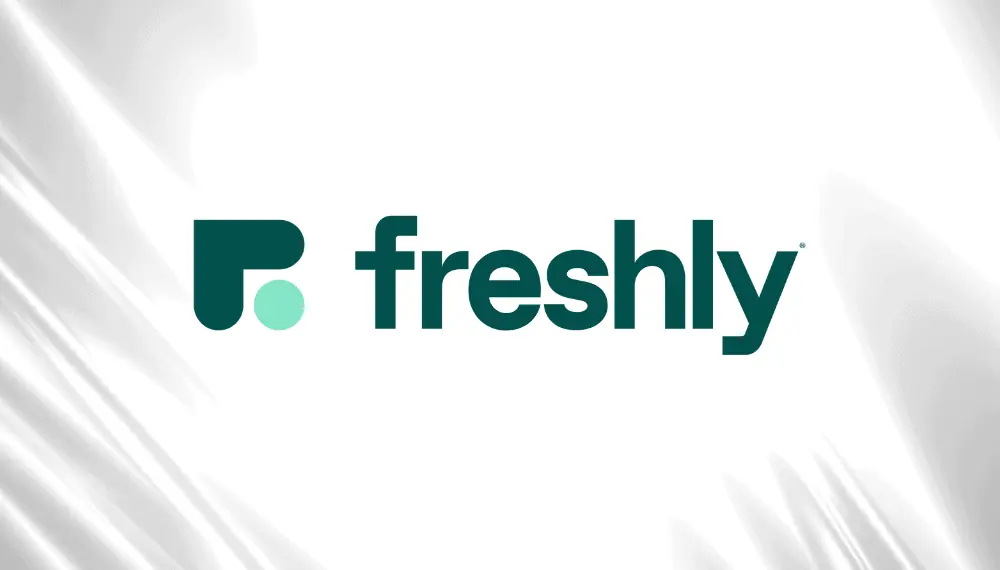It was not a surprise for many when Freshly announced that they were discontinuing their direct-to-consumer delivery. The company has been closing down facilities. Downsizing its workforce by a significant number nationwide.
According to a report submitted to the New York State Department of Labor, the company let go of 138 employees as part of its plant closure. Similarly in Phoenix, Arizona, a notice states that another 329 employees will be affected, while ABC15 Arizona reported that the company plans to lay off 454 individuals, in Maryland.
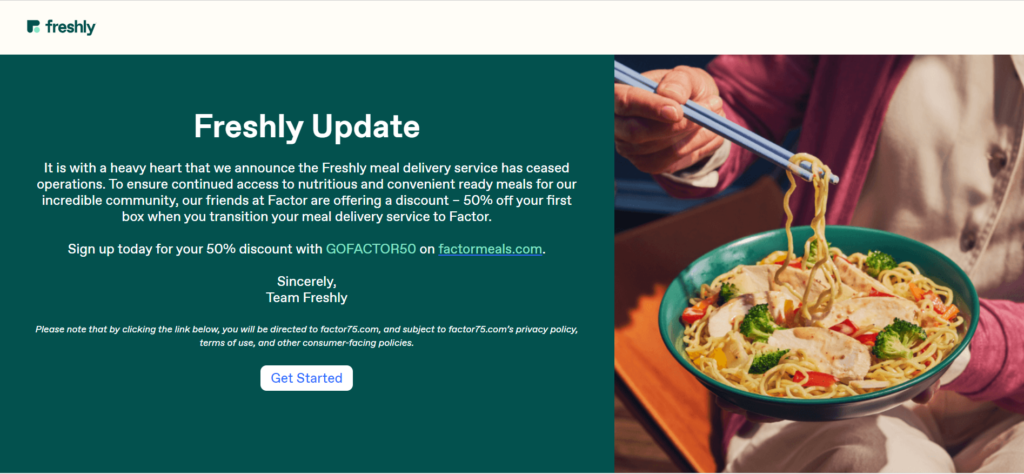
Image source: Freshly
So, what happened to Freshly? How did this meal delivery giant go out of business? There are many questions. And, we will try to find the answers today.
- Company Overview
- What Happened to Freshly?
- Challenges in the Meal Delivery Industry
- Best Strategies for Meal Delivery Companies
- Embrace Market Research and Consumer Insights
- Stay Agile and Responsive to Market Shifts
- Diversify Revenue Streams
- Invest in Customer Retention and Loyalty
- Optimize Operational Efficiency
- Sustainable and Environmentally Friendly Practices
- Foster Strategic Partnerships
- Financial Prudence and Long-Term Planning
- Conclusion
- Frequently Asked Questions (FAQs)
Company Overview
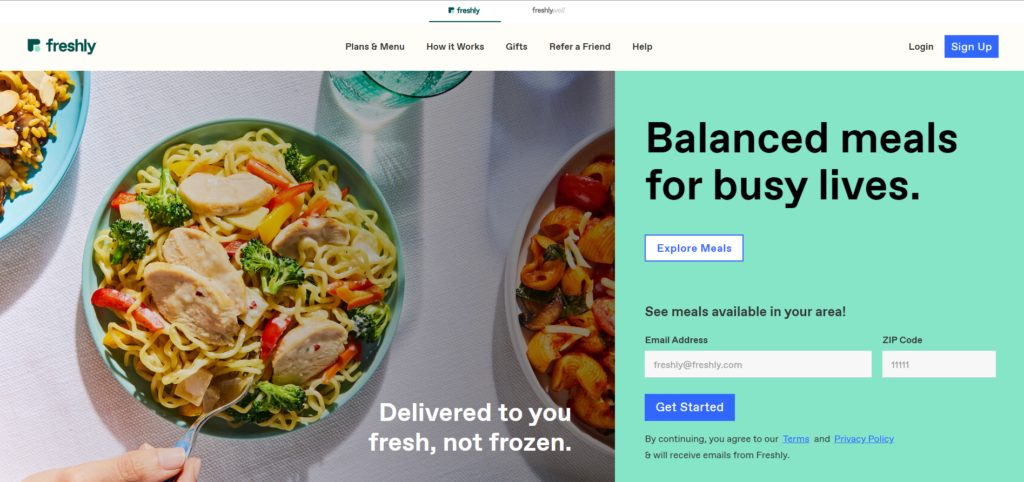
Freshly website before shutting down- Source
Freshly, a prominent player in the meal delivery industry has transformed the way people approach dining since its inception in 2015. With a focus on providing busy individuals with delicious and chef-prepared meals, the Company quickly gained traction and earned a reputation for convenience and quality.
By 2020, Freshly was thriving, with a projected sales figure of $430 million for the year. However, as the world grappled with the COVID-19 pandemic and its subsequent economic impact, the Company faced unforeseen challenges.
With consumers venturing out of their homes once again in 2021 and shifting their food expenditures towards dining out, Freshly encountered a decline in demand for its meal delivery services. Furthermore, as economic conditions worsened in 2022, many consumers opted to cut back on retail subscriptions, affecting Freshly’s performance.
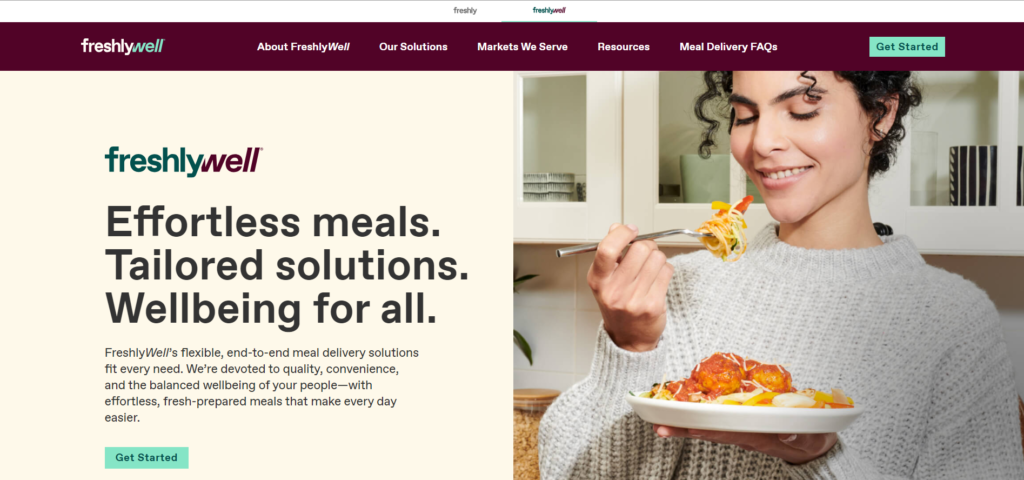
Despite these challenges, Freshly remained resilient, continually adapting to the evolving landscape of the food industry. In a market where success hinges on innovation and customer satisfaction, the Company continued to refine its offerings and expand its reach.
Notably, in 2020, Freshly caught the eye of Nestlé, leading to its acquisition by the multinational food and beverage giant, further bolstering its position in the market. But, by December 2022 things went from bad to worse, and finally, the company announced the shutdown of its delivery.
Meal and grocery delivery revenue past and projected:
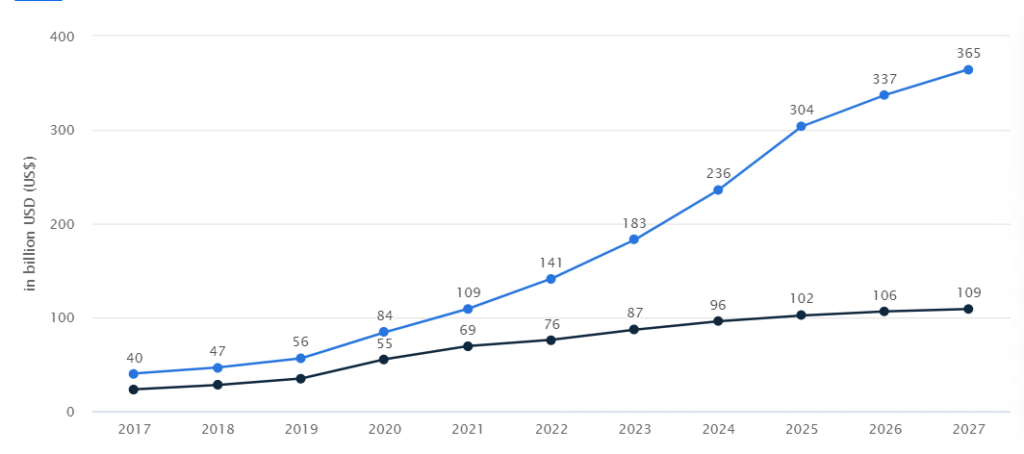
What Happened to Freshly?
So, what happened to Freshly that it had to shut down? The news left its loyal customer base and the market in disbelief, raising questions about the circumstances that led to the demise of this once-thriving company. As the dust settles, let’s explore the key factors that contributed to Freshly’s unfortunate downfall.
Operational Shutdown and Staff Reduction
When Freshly began closing plants all around the country, that was the first indication that a crisis was brewing. Financial issues within the company were indicated by reports of facility closures and considerable workforce reductions. A report submitted to the New York State Department of Labor revealed that 138 workers had been let go when the business shut down a manufacturing facility. Similar to how Maryland experienced 454 layoffs, Phoenix, Arizona, saw another 329 workers suffer the same fate. These behaviors were blatant signs of the company’s attempt to keep running amid growing difficulties.
Changing Consumer Behavior and Economic Conditions
As with many businesses, Freshly faced the repercussions of changing consumer behavior caused by external factors. With the world slowly emerging from the COVID-19 pandemic, consumers were once again venturing outside their homes to dine out, leading to a decline in demand for meal delivery services. Furthermore, economic conditions worsened in 2022, compelling many customers to tighten their budgets and cut back on non-essential expenses, including subscription services. The combination of reduced demand and challenging economic circumstances put immense strain on Freshly’s revenue streams.
Lack of Response to Market Shifts
While the meal delivery industry is highly competitive and subject to rapid shifts, Freshly’s response to changing market dynamics was called into question. Instead of adapting swiftly to the evolving needs of consumers, the company appeared to struggle to address emerging challenges. Failing to pivot effectively during crucial periods can have dire consequences in a fast-paced industry like meal delivery, leaving businesses vulnerable to setbacks and loss of market share.
Acquisition by Nestlé
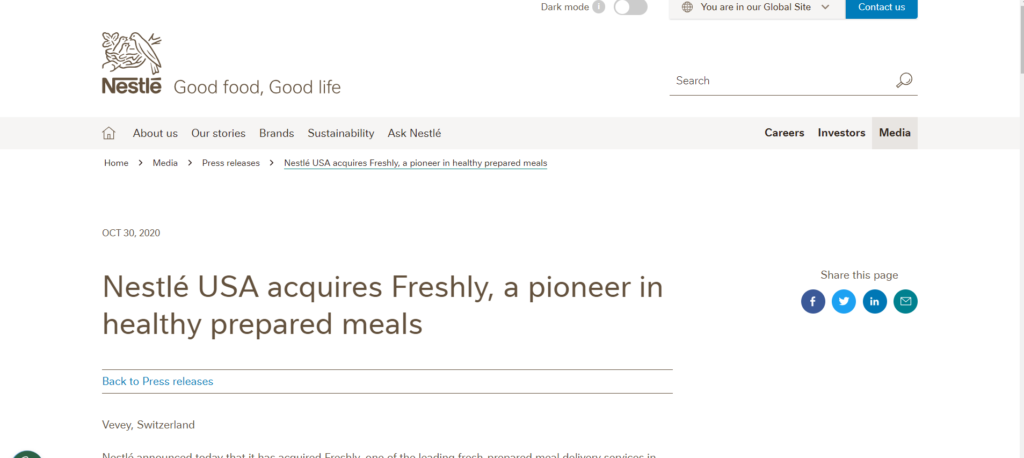
Source: Nestle
Freshly’s acquisition by Nestlé in the past had been viewed as a major milestone for the company, bolstering its position in the market. However, mergers and acquisitions can sometimes present unforeseen challenges and complexities. Integrating into a larger corporate structure may have impacted Freshly’s ability to maintain its previous agility and independence, potentially hindering its response to market changes.
Challenges in the Meal Delivery Industry

Food delivery company revenue in 2022 – Data source
The meal delivery industry has experienced unprecedented growth and popularity over the years, transforming the way people consume food. However, beneath the façade of convenience and success lies a landscape fraught with challenges that have the potential to shake even the most established players.
As companies like Blue Apron, and HelloFresh grapple with shifting consumer behavior and economic conditions, they must confront a myriad of obstacles to remain competitive and relevant in this rapidly evolving space.
- Changing Consumer Behavior
One of the primary challenges faced by the meal delivery industry is the constant evolution of consumer behavior. The COVID-19 pandemic drastically altered people’s dining habits, with a surge in demand for home-delivered meals as individuals sought safety and convenience during lockdowns.
However, as the world emerges from the pandemic, consumers are gradually returning to restaurants and dining out, resulting in a decline in demand for meal delivery services. Companies must stay attuned to these changing preferences and adjust their strategies accordingly to stay ahead in the market.
- Intense Competition
The meal delivery industry is fiercely competitive, with numerous players vying for a slice of the market. As more companies enter the space, the battle for customer attention intensifies, leading to aggressive marketing campaigns and pricing wars. Smaller startups often struggle to compete with the financial clout and established customer bases of larger corporations, making it challenging to gain traction and achieve sustainable growth.
- Economic Uncertainty
Economic conditions significantly influence consumer spending patterns. During periods of economic downturn, consumers tend to cut back on non-essential expenses, including meal delivery subscriptions. Companies in the industry must navigate through these uncertain times, offering value and flexibility to retain customers and attract new ones. Economic downturns can also impact the supply chain and increase operational costs, further complicating matters for meal delivery companies.
- Operational Complexity and Logistics
The logistics involved in meal delivery can be intricate and challenging to manage effectively. From sourcing high-quality ingredients to ensuring timely delivery to various locations, companies must orchestrate a well-coordinated and efficient operation. Unexpected issues such as transportation delays, adverse weather conditions, or sudden spikes in demand can strain resources and impact customer satisfaction.
- Balancing Quality and Cost
Maintaining a delicate balance between providing high-quality meals and keeping costs reasonable is a persistent challenge for meal delivery companies. Consumers increasingly expect fresh, organic, and sustainable ingredients, which may come at a premium. To remain competitive, companies must find innovative ways to manage expenses without compromising on the quality of their offerings.
- Environmental Impact
In an era where sustainability and environmental responsibility are significant concerns, the meal delivery industry faces scrutiny over its packaging practices and carbon footprint. The use of single-use plastics and excessive packaging materials can be detrimental to the environment, leading to public backlash and reputational damage. Companies must explore eco-friendly packaging alternatives and implement sustainable practices to mitigate their impact on the planet.
- Customer Retention and Loyalty
Acquiring new customers is essential, but retaining them is equally critical for long-term success. Meal delivery companies need to focus on building strong customer relationships, providing excellent customer service, and offering personalized experiences to foster loyalty. Ensuring customer satisfaction and addressing any concerns promptly is vital to reducing churn and increasing customer lifetime value.
The meal delivery industry’s growth and success are accompanied by a host of challenges that demand constant vigilance, adaptability, and innovation from companies operating within it. Addressing changing consumer behavior, navigating economic uncertainties, and staying ahead in a competitive landscape are just some of the hurdles meal delivery companies must overcome to thrive in this dynamic market.
By prioritizing customer needs, embracing sustainable practices, and optimizing operations, these companies can position themselves for success in the ever-evolving meal delivery industry.
![]() Suggested Reading: Food Delivery Company Strategies
Suggested Reading: Food Delivery Company Strategies
Best Strategies for Meal Delivery Companies
The untimely demise of Freshly serves as a cautionary tale for meal delivery companies, highlighting the importance of proactively addressing challenges and adapting to an ever-changing market. By learning from Freshly’s experiences, other companies in the industry can chart a path towards sustainable growth and resilience. In this article, we explore key strategies that can help meal delivery companies avoid a similar fate.
Embrace Market Research and Consumer Insights
A deep understanding of consumer preferences and behaviors is vital for success in the meal delivery industry. Companies should invest in comprehensive market research to identify emerging trends, assess competitors’ strategies, and gauge customer satisfaction. Leveraging data analytics and gathering real-time feedback will provide valuable insights to tailor offerings, refine menus, and create personalized experiences that resonate with the target audience.
Stay Agile and Responsive to Market Shifts
The meal delivery landscape is dynamic, and businesses must be agile and quick to adapt to changing market conditions. Responding promptly to shifts in consumer behavior, economic fluctuations, and industry trends will enable companies to proactively adjust their strategies and stay relevant. Flexibility and innovation should be embedded into the organizational culture to seize new opportunities and mitigate potential challenges effectively.
Diversify Revenue Streams
Relying solely on a single revenue stream can leave meal delivery companies vulnerable to fluctuations in demand. To reduce dependency on one aspect of their business, companies should explore diversifying their revenue streams. This may include partnering with corporate clients, offering specialized meal plans for dietary preferences, or expanding into adjacent markets such as catering services or food retail.
Invest in Customer Retention and Loyalty
Building strong customer relationships is a cornerstone of long-term success. Companies should prioritize customer retention efforts, such as loyalty programs, subscription incentives, and personalized communication. Offering exceptional customer service, promptly addressing feedback, and resolving issues will foster loyalty and enhance the overall customer experience.
Optimize Operational Efficiency
Streamlining operations is crucial for meal delivery companies to maintain profitability and quality. Assessing and optimizing supply chains, logistics, and production processes can help reduce costs and ensure timely and efficient deliveries. Embracing technology and automation, where applicable, can also enhance operational efficiency and minimize the risk of errors.
Sustainable and Environmentally Friendly Practices
As environmental concerns continue to grow, meal delivery companies should prioritize sustainability and eco-friendly practices. Reducing single-use plastics, implementing green packaging alternatives, and adopting energy-efficient transportation methods demonstrate a commitment to environmental responsibility and can attract environmentally conscious customers.
Foster Strategic Partnerships
Strategic partnerships can offer mutual benefits and open new avenues for growth. Collaborating with renowned chefs, local producers, or other relevant businesses can enhance the brand’s credibility and expand the range of offerings. Partnerships with technology platforms can also help reach new customer segments and improve the overall user experience.
Financial Prudence and Long-Term Planning
Prudent financial management is essential for the survival and growth of meal delivery companies. Maintaining a strong financial foundation, carefully managing expenses, and avoiding excessive debt can provide a buffer during challenging times. Companies should also focus on long-term planning, setting achievable goals, and continuously reassessing their business strategies to align with changing market dynamics.
Conclusion
Consumer preferences are changing by the minute and so is the competition. New food delivery brands are appearing in the market with better and more innovative technologies. The future is bright for companies that evolve and change with time. Unfortunately, Freshly did not survive the competition and had to shut down. But, its success story in the past is still an inspiration for many.
Frequently Asked Questions (FAQs)
What led to the demise of Freshly?
The demise of Freshly was influenced by several factors, including changing consumer behavior, economic conditions, and increased competition in the meal delivery industry.
What was Freshly's projected sales figure in 2020?
At the time of its acquisition by Nestlé, Freshly's forecasted sales for the year 2020 were $430 million.
How did the COVID-19 pandemic affect Freshly's performance?
The COVID-19 pandemic initially led to increased demand for meal delivery services like Freshly as consumers sought safer dining options. However, as restrictions eased and people returned to dining out, Freshly's performance was impacted by a decline in demand.
Were there any layoff notices filed by Freshly in different locations?
Yes, Freshly filed layoff notices in various locations indicated staff reductions as the company faced challenges. Notices were filed in New York, Phoenix, and Maryland, affecting hundreds of employees.
What were some of the specific challenges faced by Freshly before its closure?
Freshly encountered challenges such as consumer shifts to dining out, economic uncertainties, and the need to downsize its operations, impacting its overall performance.
Did Freshly make any public statements regarding its closure?
Yes, Freshly made a public statement on its website regarding the cessation of its meal delivery service. The company expressed gratitude to its community and directed customers to a FAQ section for more information.
What can other meal delivery companies learn from Freshly's experience?
Other meal delivery companies can learn the importance of adapting to market shifts, diversifying revenue streams, focusing on customer retention, and remaining financially prudent to avoid similar challenges faced by Freshly.

